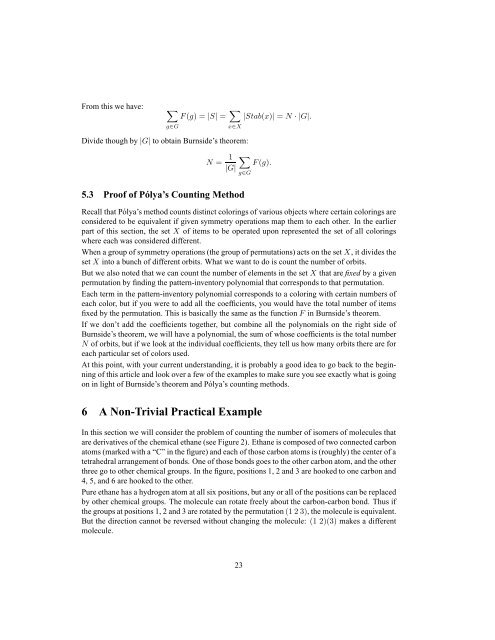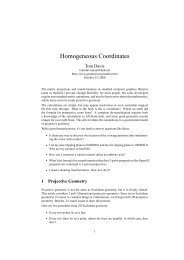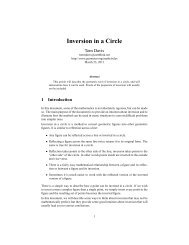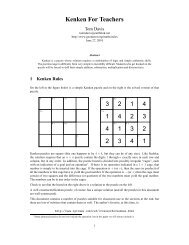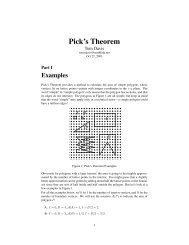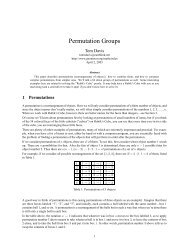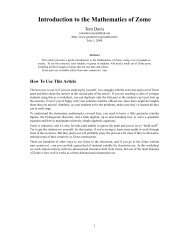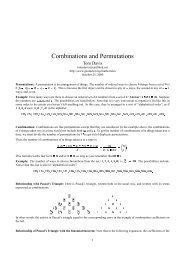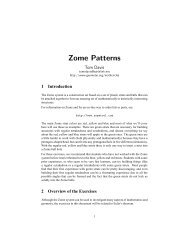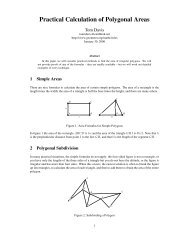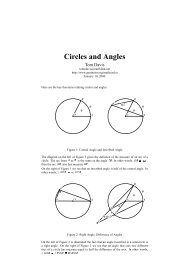P´olya's Counting Theory - Home Page -- Tom Davis
P´olya's Counting Theory - Home Page -- Tom Davis
P´olya's Counting Theory - Home Page -- Tom Davis
You also want an ePaper? Increase the reach of your titles
YUMPU automatically turns print PDFs into web optimized ePapers that Google loves.
From this we have:<br />
∑<br />
g∈G<br />
F(g) = |S| = ∑ x∈X<br />
|Stab(x)| = N · |G|.<br />
Divide though by |G| to obtain Burnside’s theorem:<br />
N = 1<br />
|G|<br />
5.3 Proof of Pólya’s <strong>Counting</strong> Method<br />
∑<br />
F(g).<br />
g∈G<br />
Recall that Pólya’s method counts distinct colorings of various objects where certain colorings are<br />
considered to be equivalent if given symmetry operations map them to each other. In the earlier<br />
part of this section, the set X of items to be operated upon represented the set of all colorings<br />
where each was considered different.<br />
When a group of symmetry operations (the group of permutations) acts on the set X, it divides the<br />
set X into a bunch of different orbits. What we want to do is count the number of orbits.<br />
But we also noted that we can count the number of elements in the set X that are fixed by a given<br />
permutation by finding the pattern-inventory polynomial that corresponds to that permutation.<br />
Each term in the pattern-inventory polynomial corresponds to a coloring with certain numbers of<br />
each color, but if you were to add all the coefficients, you would have the total number of items<br />
fixed by the permutation. This is basically the same as the function F in Burnside’s theorem.<br />
If we don’t add the coefficients together, but combine all the polynomials on the right side of<br />
Burnside’s theorem, we will have a polynomial, the sum of whose coefficients is the total number<br />
N of orbits, but if we look at the individual coefficients, they tell us how many orbits there are for<br />
each particular set of colors used.<br />
At this point, with your current understanding, it is probably a good idea to go back to the beginning<br />
of this article and look over a few of the examples to make sure you see exactly what is going<br />
on in light of Burnside’s theorem and Pólya’s counting methods.<br />
6 A Non-Trivial Practical Example<br />
In this section we will consider the problem of counting the number of isomers of molecules that<br />
are derivatives of the chemical ethane (see Figure 2). Ethane is composed of two connected carbon<br />
atoms (marked with a “C” in the figure) and each of those carbon atoms is (roughly) the center of a<br />
tetrahedral arrangement of bonds. One of those bonds goes to the other carbon atom, and the other<br />
three go to other chemical groups. In the figure, positions 1, 2 and 3 are hooked to one carbon and<br />
4, 5, and 6 are hooked to the other.<br />
Pure ethane has a hydrogen atom at all six positions, but any or all of the positions can be replaced<br />
by other chemical groups. The molecule can rotate freely about the carbon-carbon bond. Thus if<br />
the groups at positions 1, 2 and 3 are rotated by the permutation (1 2 3), the molecule is equivalent.<br />
But the direction cannot be reversed without changing the molecule: (1 2)(3) makes a different<br />
molecule.<br />
23


